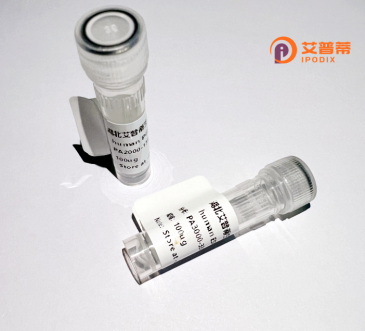
| 纯度 | >90%SDS-PAGE. |
| 种属 | Human |
| 靶点 | FMN1 |
| Uniprot No | Q68DA7 |
| 内毒素 | < 0.01EU/μg |
| 表达宿主 | E.coli |
| 表达区间 | 1-503aa |
| 氨基酸序列 | MENVDNSLDGSDVSEPAKPEAGLEVAQSILSKFSMKSLFGFTSKLESVNPEEEDAVLKAFHSLDVNPTSQQDDSSNGLDPQEAGSRVSPDLGNDEKIASVETESEGSQRKEAGTSLLAQELLPLSTLKGTKDDVICVRGTLVHTTSDSDSDDGGQEPEEGSSTNGPKSPSVVLSEPSQESKENPGGFRENTVTGEMNGAELCAEDPQRIPPEMSSKLEAGNGGLQTERRPSQDQVGEEGSQDLPAVTNQNSSVGITESASSKKEVSGEKSFQLPAFFSGLRVLKKGATAEGGETITEIKPKDGDLALLKLTQPVQKSLVQAGLQTVKSEKKATDPKATPTLLEQLSLLLNIDMPKTEPKGADPESPRREEMGCNADQESQSGPGVPQTQGGEVKPKSPETALEAFKALFIRPPRKGTTADTSELEALKRKMRHEKESLRAVFERSNSKPADGPSDSKSPDHSLTEQDDRTPGRLQAVWPPPKTKDTEEKVGLKYTEAGNVKGS |
| 分子量 | 80.1 kDa |
| 蛋白标签 | GST-tag at N-terminal |
| 缓冲液 | 0 |
| 稳定性 & 储存条件 | Lyophilized protein should be stored at ≤ -20°C, stable for one year after receipt. Reconstituted protein solution can be stored at 2-8°C for 2-7 days. Aliquots of reconstituted samples are stable at ≤ -20°C for 3 months. |
| 复溶 | Always centrifuge tubes before opening.Do not mix by vortex or pipetting. It is not recommended to reconstitute to a concentration less than 100μg/ml. Dissolve the lyophilized protein in distilled water. Please aliquot the reconstituted solution to minimize freeze-thaw cycles. |
以下是关于重组人FMN1蛋白的3篇文献概览:
1. **"Functional characterization of recombinant human FMN1 in actin filament assembly"**
- **作者**: Li, X. et al.
- **摘要**: 该研究通过大肠杆菌表达系统成功纯化重组人FMN1蛋白,并验证其通过Formin同源结构域(FH2)促进微丝成核和延伸的功能,揭示了其在细胞骨架动态调控中的作用。
2. **"Structural insights into the autoinhibition of FMN1 and its relief by Rho GTPase binding"**
- **作者**: Watanabe, N. & Higashida, C.
- **摘要**: 利用重组人FMN1蛋白的晶体结构分析,阐明其自抑制构象机制,并证明Rho信号通路(如Cdc42)激活后可解除自抑制,从而调控细胞迁移和极性形成。
3. **"FMN1 mutations impair mitochondrial dynamics and cause autosomal-dominant auditory neuropathy"**
- **作者**: Zhu, Y. et al.
- **摘要**: 通过重组FMN1蛋白功能研究,发现特定突变体(如p.R408W)导致线粒体分裂异常,与遗传性听觉神经病变相关,为疾病机制提供了分子证据。
如需更具体文献,可结合研究主题(如疾病、结构等)进一步筛选。
Recombinant human FMN1 (Formin 1) protein is a key regulator of actin cytoskeleton dynamics, produced through genetic engineering techniques for research and therapeutic applications. FMN1 belongs to the formin family, characterized by Formin Homology 1 (FH1) and FH2 domains that drive actin nucleation and elongation. It interacts with Rho GTPases to coordinate cellular processes like cell migration, cytokinesis, and vesicle trafficking. Unlike other formins, FMN1 localizes to both the cytoplasm and nucleus, suggesting roles in gene regulation. Dysregulation of FMN1 is linked to cancer metastasis, neurodevelopmental disorders, and cardiovascular diseases.
The recombinant protein, typically expressed in *E. coli* or mammalian systems with tags (e.g., His-tag), enables studies on its structure-function relationships, binding partners, and regulatory mechanisms. Its production bypasses low endogenous expression levels in native tissues, facilitating high-yield purification for biochemical assays (e.g., actin polymerization tests) and drug discovery platforms. Researchers use it to explore FMN1's crosstalk with signaling pathways like Wnt and Hippo, as well as its pathological implications in invasive cancers. Recent studies also highlight its potential as a biomarker or therapeutic target, driving demand for standardized recombinant FMN1 in biomedical research.
×